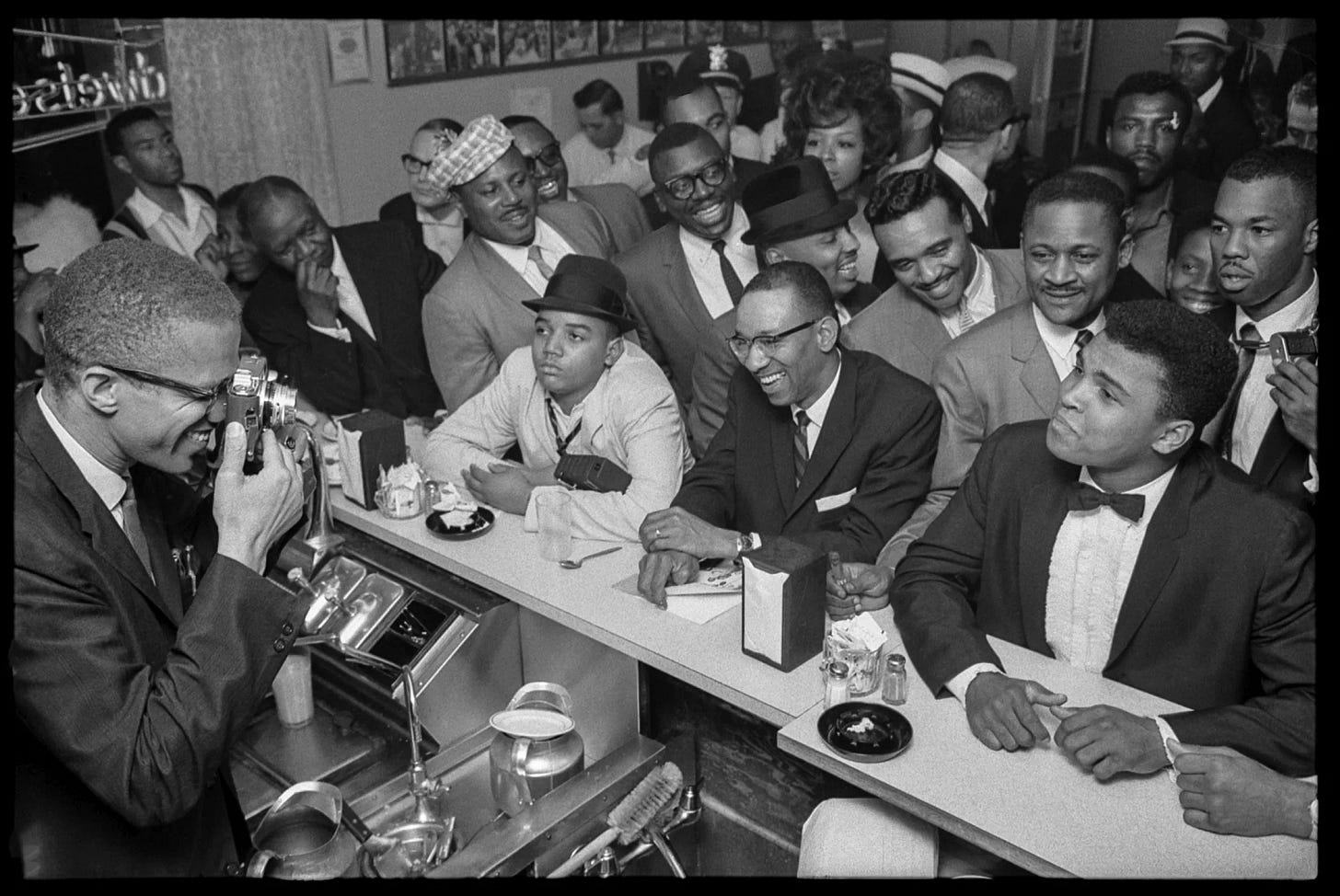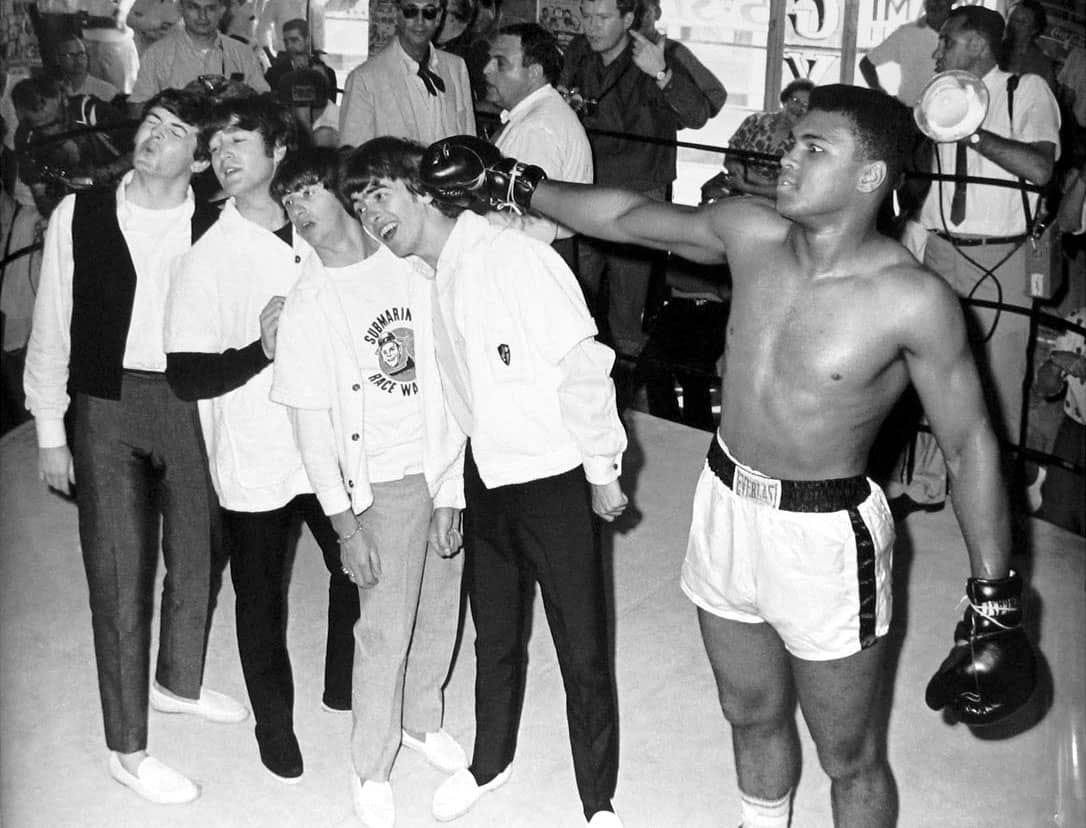"One Night in Miami"--The Fact Check
Part II of our report--the truer story. Plus: Sam Cooke's greatest performance?
Yesterday I offered an appreciation of the fine new film, One Night in Miami, now at Amazon Prime and directed by Regina King, with some caveats about the treatment of Sam Cooke—crucially, that Sam in real life had already written “A Change Is Gonna Come” without Malcolm X needling him into doing it. Today I’ll do a little more fact-checking. Hey, I’m a historian, what do you expect? Before we get to that, watch below when Sam joined Ali in the ring after Liston fell. (A few minutes earlier, as the fight ended, Ali had dashed to one side of the ring and shouted down, “Sam, didn’t I shock the world!?!”) Note: Today is Ali’s birthday. He would have been 79.
Did the four gentlemen indeed return after the Clay-Liston fight to that one room? Was Sam staying at the Fountainebleau across town with his wife?
Yes, indeed. There was an official victory party at the ritzy Fountainebleau where Sam was able to stay only because his heavy-hitting manager Allen Klein pulled some strings. The others were forced to stay at the Hampton House Motel, which had a long history as the place to stay for African-Americans during segregation times. It’s important to note that it’s impossible to fact-check almost anything said in that motel room that night as the participants barely spoke of it afterward (and Sam and Malcolm would be dead within a year). But here’s a unique return not long ago to the motel and historic room #38, with none other than Jim Brown.
Were those shadowy figure in the distance actually spying on the four men?
Yes, and there is an FBI report (which I have not read) that proves it.
Was Malcolm a photography nut?
Yes, he took many pictures on that trip and on others. Here is photo of him with his camera, a scene rendered faithfully in the movie right down to Ali’s tie.
Did Sam really “bomb” at the Copa?
Yes, but determined to prove that “a little nigger” (as he put it) could pull it off, he returned shortly after that night in Miami and was a smash. He released a live recording of this a few months later which included a song called….”Blowin’ in the Wind.” He even performed it on the debut Shindig show.
Did Sam, as Malcolm claims, seek out the Stones to deliver them Bobby Womack’s “It’s All Over Now” (recorded by Bobby as part of the Valentinos)? And did it reach #1 in America for the Stones?
No, the Stones had heard the song at a radio station and were the protagonists, not Sam. It did not reach #1 in the States—peaking at #26—but it did become the group’s first #1 hit in the UK (watch here). But all of this happened after that one night in Miami. Note: Womack later married Sam’s widow, Barbara.
Was Ali really photographed underwater in the run-up to the fight?
Yes, and it’s one of the most famous images of him ever. Numerous black performers, such as Drake and Michael B. Jordan, have since tried to duplicate the shot.
Did a syndicate of white businessmen finance Ali’s career?
Absolutely, and that’s one reason his (seeming) overnight embrace of the Nation of Islam set off such shockwaves. Then he stuck with Elijah Mohammad even though his friend and mentor Malcolm X soon split with his leader (which, many say, led to his assassination).
Were Malcolm, Sam and Jim the most famous people Ali met that week in Miami?
Maybe not. A few days before the events in the film he met The Beatles, who were in Miami for their second Ed Sullivan appearance. The boys had wanted a photo op with Sonny Liston but he refused so they turned to Ali. Then he kept them waiting so long they grew enraged but he finally won them over. He even supplied one of his typical bits of doggerel: “When Liston reads about The Beatles visiting me / He’ll get so mad, I’ll knock him out in three!” Later, however, Ali privately called the mop-top Fab Four “sissies.”
Did Malcolm really travel with Bob Dylan’s Freewheelin’ album in his suitcase and spin it for Sam in the motel room, introducing him to “Blowin in the Wind”?
Not sure about the record player, but Sam knew all about the tune long before that. His friend J.W. Alexander had given him a copy of the album months before. But the song did help inspire the writing of “A Change Is Gonna Come.” Sam more or less agreed with Malcolm’s sentiments in the movie— there needed to be such a song written by a black artist. Also, he was inspired by an incident in 1963 when he and his band members were turned away from a Holiday Inn north of Shreveport, LA, due to their race. Then they were arrested for honking their car horn loudly and persistently, bothering the white guests, as they drove away.
Did Sam debut “A Change Is Gonna Come” on the Tonight show with Johnny Carson?
Yes, he did, several months before its release on record (believe it or not, as the “B” side to his soul classic “Shake,” posthumously and with its key verse about “and I go downtown” cut for length). Unfortunately no tape exists of the historic Carson moment.
Did his three friends really not know that Jim Brown was acting in his first Hollywood movie—a bombshell he confides privately to Ali in the movie and asks him to keep a secret?
Possibly, since shooting on the film, Rio Conchos (starring Richard Boone and Stuart Whitman) did not start for about a month after the Miami episode. Brown’s work in Hollywood, still part-time, became widely publicized then. Rio Conchos did not get a national release until October 1964. Jim played two more seasons in the NFL but his sudden retirement (at his peak) was sparked by another movie—filming on The Dirty Dozen went into overtime, delaying Jim’s arrival at summer camp for the Cleveland Browns. When owner Art Modell pressured him, he simply quit—at the age of thirty. He said shooting movies was easier on his knees.
Subscribe now—it’s Free!
Song Pick of the Day Sam Cooke joined the Soul Stirrers gospel group when he was just 18 and took the gospel world by storm, soon becoming perhaps the most spectacular male singer ever in that genre before “going pop” with “You Send Me” in 1957. Here is what is often considered not only his greatest gospel performance but tops for his entire career. Yes, those thuds are the bodies of women fainting in the audience.
Greg Mitchell is the author of a dozen books, including the bestseller The Tunnels, the current The Beginning or the End, and The Campaign of the Century, which was recently picked by the Wall St. Journal as one of five greatest books ever about an election. He won more than a dozen awards as editor of Editor & Publisher magazine and for all of the 1970s he was the #2 editor at the legendary Crawdaddy. This year he wrote and directed his first film feature, Atomic Cover-up.







Whatever y’all do, don’t quit listening to the Sam Cooke gospel song Nearer To Thee before the cascading miracles toward the end! What a powerhouse.
Stuff about Dylan fascinates me more than Raquel Welch snugglies.
Hey Greg, don’t remember making a password.